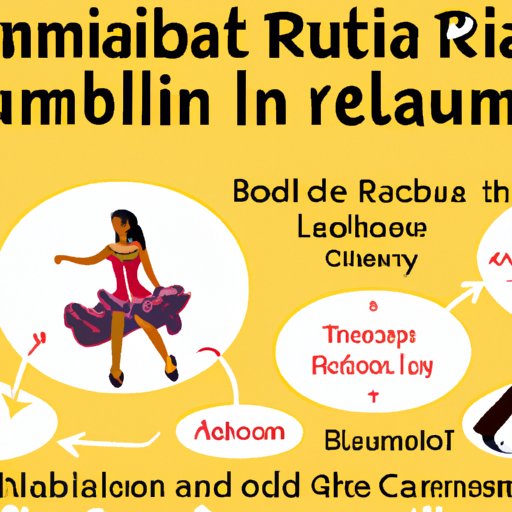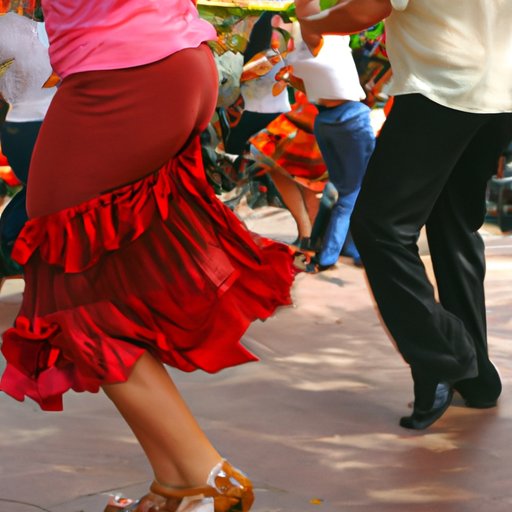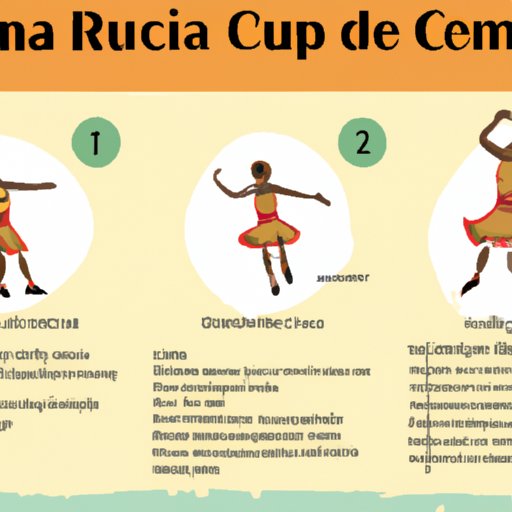Introduction
Rumba dance is a style of Latin American dance that combines elements of African, Spanish and Cuban cultures. It is an energetic, sensual and captivating dance form that originated in Cuba. The dance has evolved over time and is now popular throughout the world. It is often associated with passionate romance and is a great way to express yourself and have fun.

History of Rumba Dance: Exploring the Origins and Influences of the Latin American Dance
The origins of rumba dance can be traced back to the 19th century when African slaves were brought to Cuba by the Spanish colonists. The slaves mixed their traditional music and dances with the culture of the colonizers, creating a unique fusion of styles. Over time, this fusion developed into the various forms of rumba dance that are popular today.
Rumba dance has been strongly influenced by African, Spanish and Cuban cultures. African rhythms and moves have been blended with Cuban sounds and steps, creating a truly unique style. Spanish influences can also be seen in some of the more intricate footwork and arm movements. Each region of Cuba has its own distinct style of rumba dance, which reflects its own cultural heritage.
As the popularity of the dance spread around the world, it began to take on different forms. The Cuban-style rumba is still the most popular, but other countries have adapted the dance to suit their own cultures. For example, in Europe, rumba has been heavily influenced by ballroom dance, while in North America there is a strong hip hop influence.
A Step-by-Step Guide to Learning the Rumba Dance
Learning the basic steps and techniques of rumba dance is the first step towards mastering the art. The most important thing to remember is that rumba is a dance of passion and emotion, so don’t be afraid to let your body move freely and express yourself. Start by practicing the basic steps and familiarizing yourself with the rhythm and timing of the music.
Once you have mastered the basics, you can start to add more complex steps and combinations. Try incorporating turns, spins and dips into your routine, as well as experimenting with different rhythms and tempos. As you become more confident with the dance, you can add more advanced movements and combinations. Practice regularly and listen to the music to get a feel for the different styles of rumba.
To perfect your rumba skills, it is important to practice with a partner. This will help you develop your sense of connection and musicality with each other. You can also practice with a group and learn from each other’s mistakes. With enough practice and dedication, you can master the art of rumba dancing.
Dressing for a Rumba: Tips for Outfitting Yourself for the Latin-Inspired Dance
When it comes to dressing for a rumba, it is important to choose clothing that is comfortable and allows for freedom of movement. Loose-fitting garments such as skirts, dresses and shirts are ideal, as they allow you to move freely. Make sure to pick colors and fabrics that flatter your complexion and figure. Accessories such as necklaces, earrings and bracelets can also help to complete your look.
In addition to your clothing, it is important to consider your hairstyle. A classic updo or a low ponytail are both great options for a rumba dance. If you’re feeling adventurous, you can even try a bun or a braid. Whatever you choose, make sure it is secure and won’t get in the way of your dancing.
Benefits of Taking Rumba Dance Classes: Exploring the Physical and Mental Health Benefits
Taking rumba dance classes can provide numerous physical and mental health benefits. Physically, dancing helps to improve coordination, balance and flexibility, as well as strengthening your muscles. It is also a great way to burn calories and stay fit. Mentally, dancing can help to reduce stress, improve focus and concentration, and increase self-confidence.
In addition to these physical and mental benefits, taking rumba classes can also be a great way to socialize and meet new people. Many classes offer opportunities to perform in shows or competitions, allowing you to showcase your skills and gain recognition. Overall, taking rumba classes can be a great way to stay healthy and have fun.

Rumba Dance Around the World: Exploring Different Styles and Cultural Influences
Rumba dance is popular all over the world, with each country having its own unique style. In Europe, the dance is heavily influenced by ballroom dance, while in Latin America it retains its original Cuban roots. In the United States, hip hop has had a major influence on the evolution of the dance. Each style has its own distinctive flavor, reflecting the cultural influences of the region.
No matter where you are, rumba dance is an enjoyable and exhilarating experience. Whether you’re looking for a fun way to exercise or just want to explore a new culture, rumba dance is the perfect choice. So why not give it a try and see what this captivating dance form has to offer?
Conclusion
Rumba dance is a captivating and exciting Latin American dance form that has been influenced by African, Spanish and Cuban cultures. It is an energetic, sensual and expressive dance form that can provide numerous physical and mental health benefits. There are many different styles of rumba dance around the world, each with its own unique flavor.
(Note: Is this article not meeting your expectations? Do you have knowledge or insights to share? Unlock new opportunities and expand your reach by joining our authors team. Click Registration to join us and share your expertise with our readers.)
